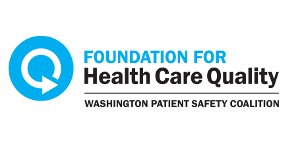A Safe Space to Discuss Diagnostic Quality
Washington Patient Safety Coalition
The following is an interview with Steve Levy, Executive Director of the Washington Patient Safety Coalition (WPSC); Randal Moseley, MD, FACP, Medical Director of Quality at Confluence Health and former WPSC Steering Committee chair; and Emily Wittenhagen, Marketing & Communications Manager for WPSC. Emily has since completed her studies and left WPSC to pursue a career in nutrition.
WPSC is a program of the Foundation for Health Care Quality that acts as a neutral hub uniting a diverse range of healthcare stakeholders to achieve common patient safety goals.
How did WPSC choose diagnostic process improvement as a key initiative for 2018-2019?
“I attended the Diagnostic Error in Medicine conference hosted by the Society to Improve Diagnosis in Medicine (SIDM) in 2017,” said Randal Moseley, MD, FACP. “That meeting elevated diagnostic error as a quality problem, and it motivated me to push for diagnostic quality and improvement to be one of WPSC’s strategic priorities at our 2018 strategic planning session.”
When Dr. Moseley presented the idea, discussion revealed considerable variation in the awareness of this problem among committee members.
“Once we reviewed information on the prevalence and impact of diagnostic error, committee members agreed to adopt improving the diagnostic process as one of our two major initiatives for 2018-2019.”
The newly formed Diagnostic Improvement Action Planning subcommittee organized the work into three tactics: raising awareness of the issue, developing a focus through collaboration and evidence-base, and promoting collaborative diagnosis—including the patient and his/her family. Given the lack of awareness amongst even its own membership, WPSC focused its early work on tactic one: raising awareness of diagnostic error.
What has WPSC done to raise awareness of diagnostic error among its members and other audiences?
“We implemented a broad, content-rich educational program around the diagnostic process that included webinars, a podcast, sessions at our annual conference, and a new concept called ‘Safe Table,’” said Steve Levy.
The concept of Safe Table was to create a psychologically safe space where WPSC members could openly discuss various healthcare issues, network with fellow leaders, and share resources. For the inaugural Safe Table luncheon, WPSC extended an invitation to all its members—every major health system in the state of Washington—for a two-hour discussion about diagnostic improvement.
“The turnout and feedback were fantastic,” said Levy. “There were 19 attendees representing 16 healthcare organizations, including non-acute care and a diagnostic clinic. Representatives openly discussed issues related to diagnostic error and improvement at their institutions and left with a shared understanding that diagnostic error is an issue we all must deal with.”
To ensure its members had a variety of resources to learn from, WPSC developed tools that addressed diagnostic error from many angles.
“We wanted to paint a full picture of the complexity of the topic, and give every kind of healthcare professional something that was relevant and helpful,” said Emily Wittenhagen.
For example, each of the four Diagnostic Improvement Series webinars was focused on a different topic: the impact of health IT on diagnosis, the research around clinician cognition, the importance of patient and family engagement, and team-based approaches to diagnosis. Two of the four sessions were led by SIDM representatives.
“We also wanted integrate diagnosis-specific conversations into our 2019 Northwest Patient Safety Conference, so we invited SIDM’s Mark Graber and Sue Sheridan to be our closing speakers,” said Levy. “We even had patients share stories using SIDM’s ‘What If’ model, because patient perspective is critical to our work.”
What about the second and third tactics you outlined in your strategic plan? Are patients involved in those processes, too?
“Patient is in our name, so we feel strongly that the collaboration mentioned in tactics two and three—developing a focus through collaboration and evidence-base, and promoting collaborative diagnosis—means involving patients and elevating their voices,” said Wittenhagen.
WPSC recently began its work on tactic two, focusing first on developing a toolkit for patients and curriculum for clinicians on how to apply collaboration to diagnosis. The organization also encourages its members to implement the Communication Resolution Program (CRP).
“CRP helps healthcare institutions address harm when it occurs, rather than default to the ‘deny and defend’ method,” said Levy. “I think the U.S. is doing a better job of recognizing and collecting data about diagnostic error causing patient harm, but the CRP work is where we do something to address it when it occurs, all while acknowledging patients physical and financial needs and engaging them in the quality improvement process.”
Dr. Moseley is one of the main CRP project coordinators, leading by example with his own work at Confluence Health.
“Our main focus now is continuing to raise awareness and maintain interest in diagnostic improvement,” said Dr. Moseley. “It still feels like a topic that people want to know more about, so we want to continue to get the right materials in front of the right people so that we can effect change.”
Resources
- Webinar recordings, including the four-part Diagnostic Improvement Series
- Podcast: Interview with Paul Epner, CEO and co-founder of SIDM
- Blog Post: Hitting The Bullseye: The Important Role of Diagnostic Accuracy in Patient Safety
Newsletters that have been devoted to diagnostic improvement:

Get ACT Update Delivered to Your Inbox
Want to see more content like this? Stay informed on that latest activities from members of the Coalition to Improve Diagnosis. Sign up for the ACT Update Newsletter.
